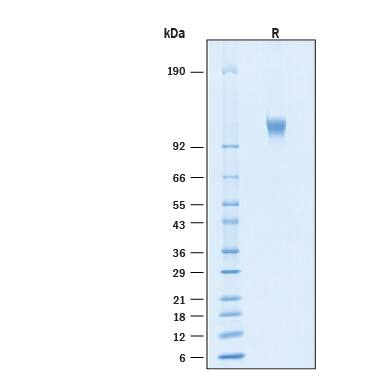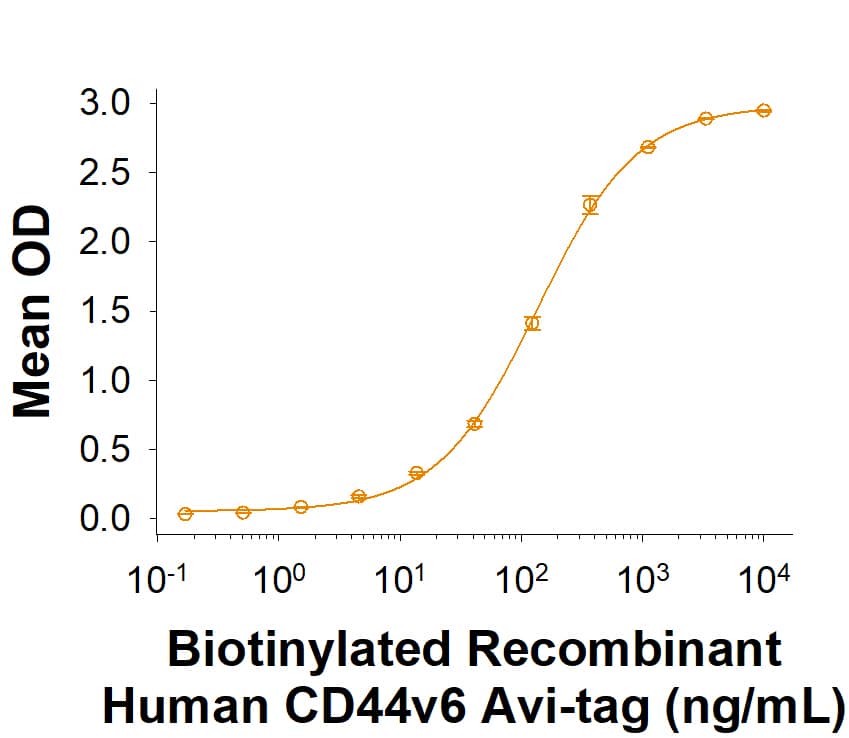Recombinant Human CD44v6 Fc Chimera Avi-tag Protein, CF
R&D Systems, part of Bio-Techne | Catalog # AVI11175

Key Product Details
- R&D Systems HEK293-derived Recombinant Human CD44v6 Fc Chimera Avi-tag Protein (AVI11175)
- Quality control testing to verify active proteins with lot specific assays by in-house scientists
- All R&D Systems proteins are covered with a 100% guarantee
Source
HEK293
Structure / Form
Disulfide-linked Homodimer
Biotinylated via Avitag
Biotinylated via Avitag
Conjugate
Biotin
Applications
Bioactivity
Product Specifications
N-terminal Sequence Analysis
Gln21, inferred from enzymatic pyroglutamate treatment revealing Ile22
Predicted Molecular Mass
60 kDa
SDS-PAGE
105-120 kDa, under reducing conditions
Scientific Data Images for Recombinant Human CD44v6 Fc Chimera Avi-tag Protein, CF
Biotinylated Recombinant Human CD44v6 Fc Chimera Avi-tag Protein Binding Activity.
Measured by its binding ability in a functional ELISA. Biotinylated Recombinant Human CD44v6 Fc Chimera Avi-tag Protein (Catalog # AVI11175) binds to Recombinant Human LSECtin/CLEC4G Protein (2947-CL) with an ED50 of 40.0-400 ng/mL.Biotinylated Recombinant Human CD44v6 Fc Chimera Avi-tag Protein SDS-PAGE.
2 μg/lane of Biotinylated Recombinant Human CD44v6 Fc Chimera Avi-tag Protein (Catalog # AVI11175) was resolved with SDS-PAGE under reducing (R) condition and visualized by Coomassie® Blue staining, showing bands at 105-120 kDa.Formulation, Preparation and Storage
AVI11175
| Formulation | Lyophilized from a 0.2 μm filtered solution in PBS with Trehalose. |
| Reconstitution | Reconstitute at 500 μg/mL in PBS. |
| Shipping | The product is shipped at ambient temperature. Upon receipt, store it immediately at the temperature recommended below. |
| Stability & Storage | Store the unopened product at -20 to -70 °C. Use a manual defrost freezer and avoid repeated freeze-thaw cycles. Do not use past expiration date. |
Background: CD44
References
- Ponta, H. et al. (2003) Nat. Rev. Mol. Cell Biol. 4:33.
- Screaton, G.R. et al. (1992) Proc. Natl. Acad. Sci. USA 89:12160.
- Screaton, G.R. et al. (1993) J. Biol. Chem. 268:12235.
- Lynch, K.W. (2004) Nat. Rev. Immunol. 4:931.
- Todaro, M. et al. (2014) Cell stem cell 14:342.
- Vizoso, F.J. et al. (2004) J. Cancer Res. Clin. Oncol. 130:679.
- Ma, L. et al. (2019) Cell Death Dis. 10:30.
- Yu, Q. and B.P. Toole (1996) J. Biol. Chem. 271:20603.
- Nagano, O. and H. Saya (2004) Cancer Sci. 95:930.
- Nakamura, H. et al. (2004) Cancer Res. 64:876.
- Murakami, D. et al. (2003) Oncogene 22:1511.
- Lammich, S. et al. (2002) J. Biol. Chem. 277:44754.
Alternate Names
CD44, ECMR-III, HCAM, HCELL, LHR, MDU2, MDU3, MIC4, MUTCH-I, Pgp1
Gene Symbol
CD44
Additional CD44 Products
Product Documents for Recombinant Human CD44v6 Fc Chimera Avi-tag Protein, CF
Product Specific Notices for Recombinant Human CD44v6 Fc Chimera Avi-tag Protein, CF
For research use only
